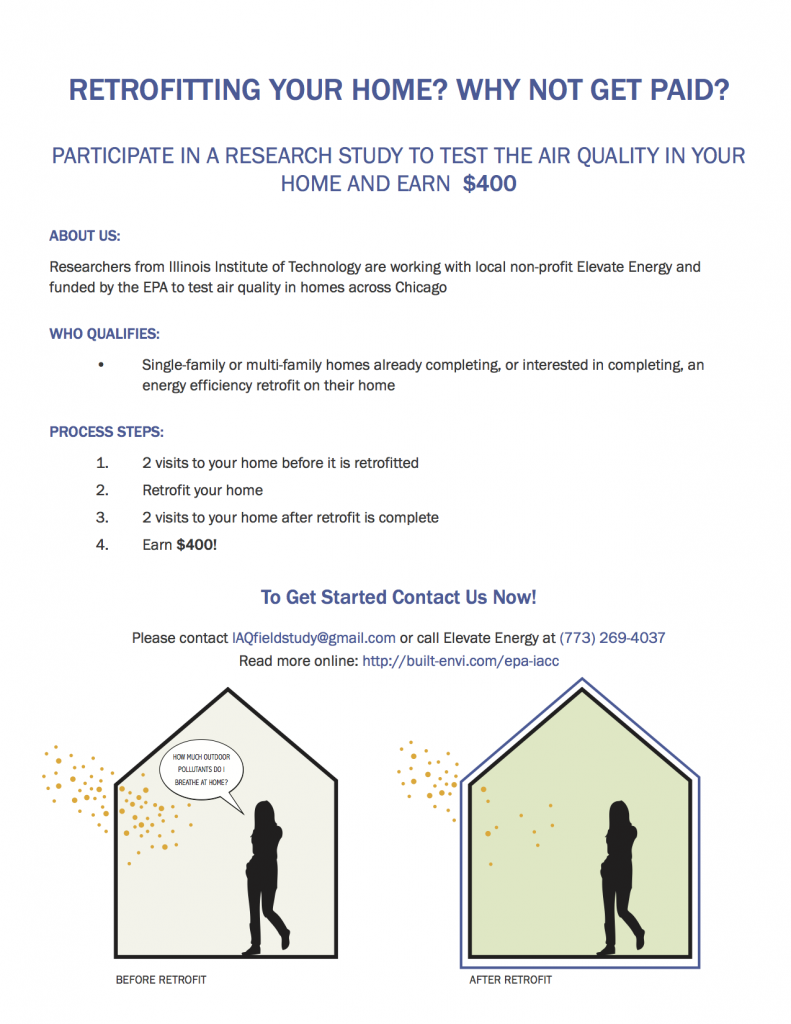Indoor air and climate change
Combining measurements and models to predict the impacts of climate change and weatherization on indoor air quality and chronic health effects in U.S. residences
We are currently recruiting volunteers for this study — earn $400 for participating!
Email iaqfieldstudy [at] gmail.com to learn more.
Americans spend most of their time inside their homes (Klepeis et al., 2001) where they are often exposed to a number of pollutants of both indoor and outdoor origin (Jones, 1999; Sax et al., 2004; Meng et al., 2005; Wallace and Williams, 2005; Weschler, 2006; Wallace and Ott, 2011). The cumulative chronic health impacts from inhalation of indoor pollutants, excluding radon and secondhand smoke, are estimated to result in between 400 and 1,100 disability-adjusted life-years (DALYs) lost per 100,000 persons per year, representing 5-14% of the annual non-communicable, non-psychiatric disease burden in the U.S. (Logue et al., 2012). Estimates of cumulative lifetime cancer risks from exposure to a combination of several hazardous indoor air pollutants in homes typically range from 1 to 10 excess cases per 10,000 people (Wallace, 1991; Sax et al., 2006; Hun et al., 2009). Therefore, indoor air quality is an important aspect of public health, but a number of challenges remain to providing healthy indoor air in homes, particularly under the influences of a changing climate that will impact buildings in a number of ways.
Climate change is expected to impact the concentrations of airborne pollutants inside buildings in both direct and indirect ways, which may have serious implications for human exposures and public health (IOM, 2011; Spengler, 2012; Nazaroff, 2013). The predicted impacts of climate change on indoor air quality and health can be grouped into three general categories:
- Climate change is expected to lead to changes in some outdoor pollutant concentrations, particularly for ozone and possibly for particulate matter, which will also manifest as changes in indoor pollutant concentrations because outdoor pollutants can infiltrate into buildings with varying efficiencies;
- Climate change is expected to lead to changes in meteorological conditions that will impact existing building performance, operation, and human behaviors, including changes in air infiltration rates, air-conditioner operation, and window opening patterns, which have competing effects on indoor pollutant concentrations; and
- Climate change is expected to lead to widespread policy responses that influence the ways in which we design and construct buildings, including improving energy efficiency across the building stock by implementing energy efficient building practices in new construction and widespread application of weatherization retrofits in existing buildings. These practices are expected to decrease ventilation rates and increase concentrations of a number of indoor-generated pollutants, while subsequently decreasing concentrations of a number of outdoor-generated pollutants.
The magnitudes and directions of many changes to indoor air quality and the associated public health burden of indoor exposures in response to these combined impacts of climate change remain unknown. Therefore, the overarching goal of this proposal is to combine field measurements with models to predict the impacts of both changing meteorological conditions in future climate scenarios and widespread application of weatherization retrofits on indoor air quality and chronic health effects in residential buildings across the United States. The goal of this work will be met by three primary objectives:
- We will utilize a nationally representative set of dynamic residential indoor air quality models to predict indoor concentrations, indoor exposures, and associated chronic health effects of several priority pollutants of both indoor and outdoor origin across the current residential building stock.
- We will apply the same model set to predict the prevalence of chronic health impacts associated with both future climate scenarios (based on direct meteorological impacts) and future climate policies (based on a number of scenarios of widespread weatherization retrofits and turnover of the existing building stock to more energy efficient homes).
To support the modeling effort and to improve our empirical knowledge of indirect impacts of climate change on indoor environments, we will also perform novel field experiments in 30 existing homes to measure ventilation rates (which affect indoor concentrations of pollutants of both indoor and outdoor origin) and infiltration factors for a number of priority outdoor-generated pollutants (as well as the fundamental drivers of infiltration factors, including indoor deposition rates and envelope penetration factors), both before and after weatherization retrofits are applied. A small subset of five of these homes will also be measured with different mechanical ventilation systems operating.
Expected outputs include: (1) novel measurements of key factors governing indoor pollutant concentrations in homes both before and after weatherization retrofits are applied; (2) novel model results of the combined impacts of future climate scenarios on indoor concentrations of several priority pollutants and associated chronic health effects; and (3) a set of large nationally representative indoor air quality models will be made available online as a free tool for others to use. The expected benefits of this combination of outputs is that stakeholders will be better equipped to address a number of important issues associated with indoor air quality and health in a changing climate. Results will also directly inform solutions to chronic indoor environmental problems in a future climate and therefore improve the public’s ability to protect the environment and human health. Results will also inform weatherization guidelines of the impact of retrofits on indoor air quality and health.
As part of this project, we have developed a custom set of nationally representative building energy and IAQ mass balance models that predict annual energy use for space conditioning and indoor concentrations of a number of pollutants of both indoor and outdoor origin across the U.S. residential building stock. The residential energy and indoor air quality (REIAQ) model framework is built in Python and integrates between EnergyPlus and a dynamic mass balance model. Read more about REIAQ here.
This project is funded by the US Environmental Protection Agency (EPA-G2014-STAR-A2)

